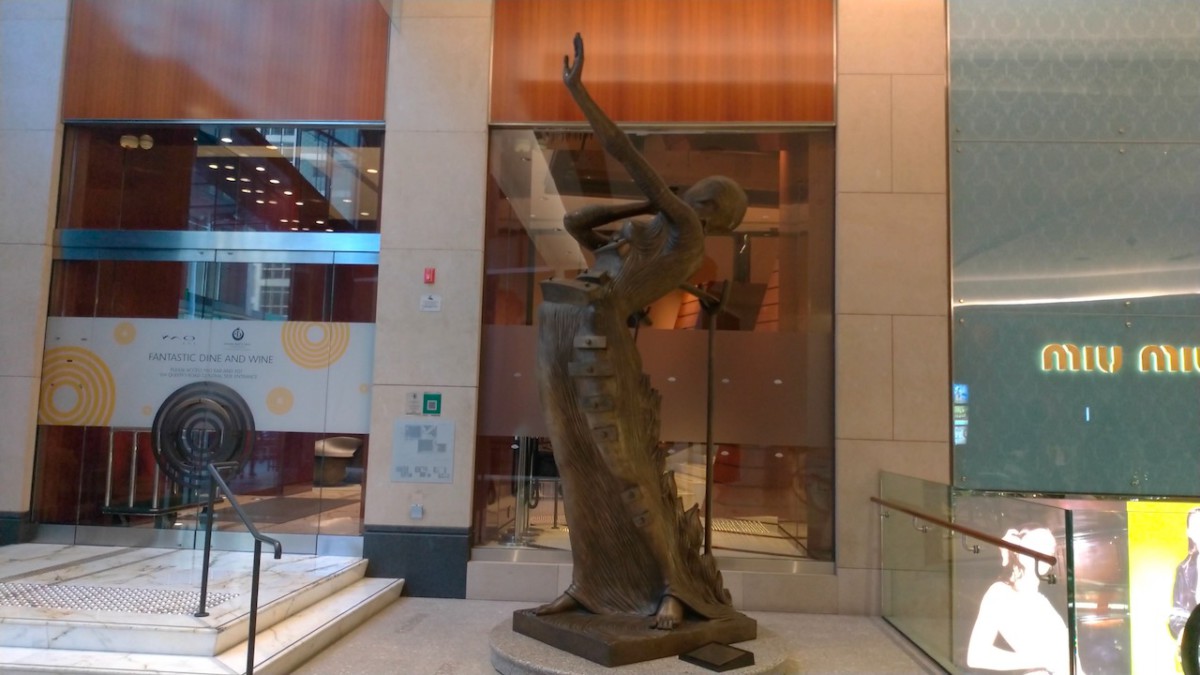語音導遊介紹:3分07秒
位置:廣場地下
位處中環心臟地帶的置地廣塲中庭原址為香港大酒店,四座相連的購物商場不時也會舉行藝術展覧,商場內亦長期展出由國際藝術大師及本地藝術家創作的藝術名作。
其中最出名的展品是位於約克大廈近入口處,一座三百六十厘米高由藝術家達利創作的青銅雕塑作品- 燃燒的女人。獲封為普波爾侯爵的薩爾瓦多•達利(Salvador Dalí)是一位舉足輕重的超現實主義畫家,年輕時的達利在馬德里的聖費南度皇家藝術學院讀書。後來在巴黎結識了超現實主義的藝術家畢卡索等人,並於不久之後成為超現實主義運動其中一位領導者,在西班牙與畢卡索和胡安·米羅被譽為西班牙後三大藝術家。在達利的一生中,他貫徹縱容自己怪僻和放任的行為,並聲稱這是他的創作力量的泉源。達利擁有非常出色的繪圖技巧,這讓其超現實作品的影像雖然怪異,卻又異常突出,舉世聞名。達利喜與從事不同媒介的藝術家合作,所以他的藝術領域非常廣闊,甚至涵蓋電影、雕塑和攝影。
達利的雕塑作品 -「龍蝦電話」(Lobster Telephone,一九三六年)、「梅維斯的唇型沙發」(Mae West Lips Sofa,一九三七年),是超現實主義運動中最著名的兩件物品,而另一作品「記憶的永恆」(La persistencia de la memoria,一九三一年),被稱作「軟鐘」的油畫,畫中的時鐘由硬變軟,掛在樹枝、桌沿及達利身上,時至今日「軟鐘」圖案仍然廣為不少設計品仿效。而展示於置地廣場中庭的青銅雕塑 – 「燃燒中的女人」(Woman Aflame,一九八零年),結合了達利最愛的兩個象徵符號:火以及抽屜。達利之所以對火焰充滿迷戀,是因為它對旁觀者有着近乎催眠的影響。至於抽屜,則象徵孩童對密閉的空間有一種與生俱來的好奇心,總要探索一番,藉此看看裏面藏着什麼東西,同時驅走對未知的恐懼。這些抽屜都是微微開着 的,象徵其中的秘密已被知曉,無需要再感到害怕。
置地廣場並沒有把這件價值不菲的達利雕塑品圍封,可以近看甚至觸摸,走到銅像背面還可以在其底座看到達利的簽名,而旁邊「2/8 」的標記是代表此作品做了八件,這是其中的第二件。
